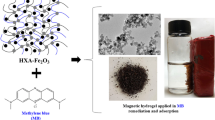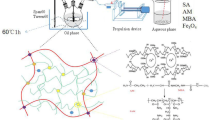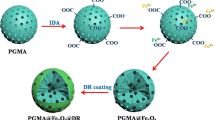Abstract
We have previously demonstrated that dark materials (DM) in acidified molasses are effectively adsorbed to Amberlite XAD7HP resin and are eluted from the resin with 0.1 M sodium hydroxide. In this paper, we have characterized the self-assembly behavior of molasses DM by using dynamic and static light scattering in combination with isoelectric focusing and infrared absorption spectroscopy in order to better understand the resin adsorption mechanism. One of DM derivatives, X-G2, contained carboxyl and hydroxyl groups and had a weight-average molar mass of 9.39 × 103 to 4.42 × 104 at pH 2.1–11.5. The aggregates retained their spherical shape over the full pH range and the large gyration radius (66.4–80.0 nm) indicated that the inner structure was loosely packed. Furthermore, X-G2 had an isoelectric point of 1.8, and its density increased sharply at pH 5.9 and then approached a nearly constant value under alkaline conditions. In summary, the self-assembly processes of DM are controlled by intermolecular hydrogen-bonding and hydrophobic interactions. The aggregates adsorb to the resin through hydrophobic interactions and are eluted when excess carboxylate anions are generated.




Similar content being viewed by others
References
Agarwal CS, Pandey GS (1994) Soil pollution by spent wash discharge: depletion of manganese (II) and impairment of its oxidation. J Environ Biol 15:49–53
Burchard W, Schmidt M, Stockmayer WH (1980) Information on polydispersity and branching from combined quasi-elastic and intergrated scattering. Macromolecules 13:1265–1272
Bustamante MA, Paredes C, Marhuenda-Egea FC, Pérez-Espinosa A, Bernal MP, Moral R (2008) Co-composting of distillery wastes with animal manures: carbon and nitrogen transformations in the evaluation of compost stability. Chemosphere 72:551–557
Chandra R, Pandey PK (2001) Decolourisation of anaerobically treated distillery effluent by activated charcoal adsorption method. Industrial J Environ Prot 2:132–134
Chandra R, Singh H (1999) Chemical decolourisation of anaerobically treated distillery effluent. Ind J Environ Prot 19:833–837
Chuang TC, Lai CL (1978) Study on treatment and utilization of molasses alcohol slop. In: Proceedings of the international conference on water pollution control in developing countries. Asia Institute of Technology, pp 513–524
Coca M, García MT, González G, Peña M, García JA (2004) Study of coloured components formed in sugar beet processing. Food Chem 86:421–433
FitzGibbon FJ, Nigam P, Singh D, Marchant R (1995) Biological treatment of distillery waste for pollution-remediation. J Basic Microbiol 35:293–301
Harris DC (2007) Quantitative chemical analysis, 7th edn. WH Freeman and Company, New York
Hatano K, Kikuchi S, Miyakawa T, Tanokura M, Kubota K (2008) Separation and characterization of the colored material from sugarcane molasses. Chemosphere 71:1730–1737
Hatano K, Kikuchi S, Nakamura Y, Sakamoto H, Takigami M, Kojima Y (2009) Novel strategy using an adsorbent-column chromatography for effective ethanol production from sugarcane or sugar beet molasses. Bioresource Technol 100:4697–4703
Kannabiran B, Pragasam A (1993) Effect of distillery effluent on seed germination, seedling growth and pigment content of Vigna mungo (L.) Hepper (C.V.T.9). Geobios 20:108–112
Kim SB, Hayase F, Kato H (1985) Decolourisation and degradation products of melanoidins on ozonolysis. Agric Biol Chem 49:785–792
Kononova VA, Aksenva VB (1963) Hygienic basis for sanitary-protective zones separating living areas and livestock farms. Gig Sanit 28:7–11
Mersad A, Fargues C, Lewandowski R, Decloux M (2003) Sugar colorants: molar masses and retention by cross-flow filtration assessed by size exclusion chromatography on Superose 12. Zuckerindustrie 128:434–442
Pike ER, Pomeroy WRM, Vaughan JM (1975) Measurement of Rayleigh ratio for several pure liquids using a laser and monitored photon-counting. J Chem Phys 62:3188–3192
Provencher SW (1982) CONTIN—a general-purpose constrained regulation program for inverting noisy linear algebraic and integral-equations. Comput Phys Commun 27:229–242
Tanokura M, Tasumi M, Miyazawa T (1976) 1H nuclear magnetic resonance studies of histidine-containing di- and tripeptides. Estimation of the effects of charged groups on the pK a value of the imidazole ring. Biopolymers 15:293–301
Acknowledgments
The authors are grateful to Mr. Satoshi Kikuchi and Kazuhide Suzuki (Gunma University) for their help in the LS and CEC experiments, respectively. Financial support for this research was provided by Fuji Nihon Seito Corporation, by Japan Science and Technology Agency (JST), and partly by the “Element Innovation” Project under the Ministry of Education, Culture, Sports, Science and Technology in Japan.
Author information
Authors and Affiliations
Corresponding author
Additional information
Responsible editor: Philippe Garrigues
Rights and permissions
About this article
Cite this article
Hatano, Ki., Komatsu, I., Aoyagi, N. et al. A study on the self-assembly behavior of dark materials from molasses. Environ Sci Pollut Res 20, 4009–4017 (2013). https://doi.org/10.1007/s11356-012-1364-4
Received:
Accepted:
Published:
Issue Date:
DOI: https://doi.org/10.1007/s11356-012-1364-4




